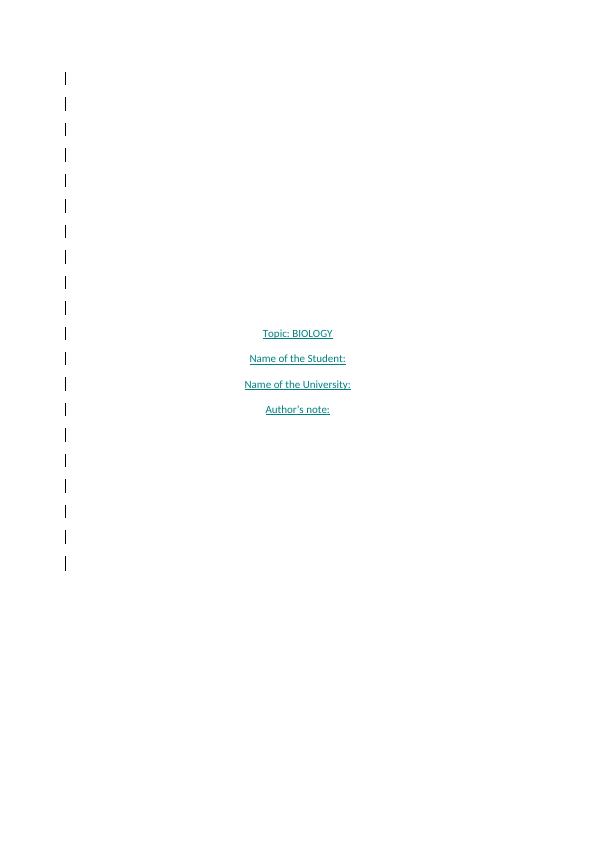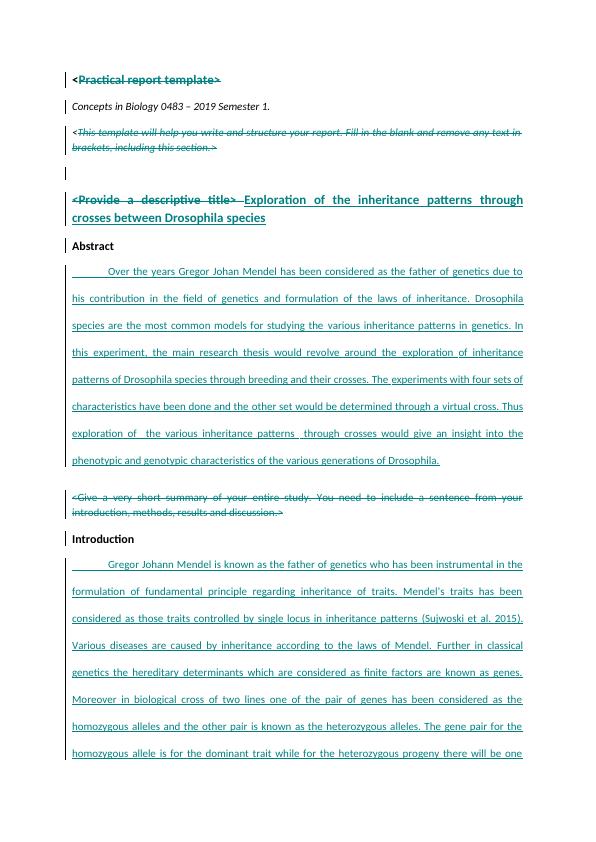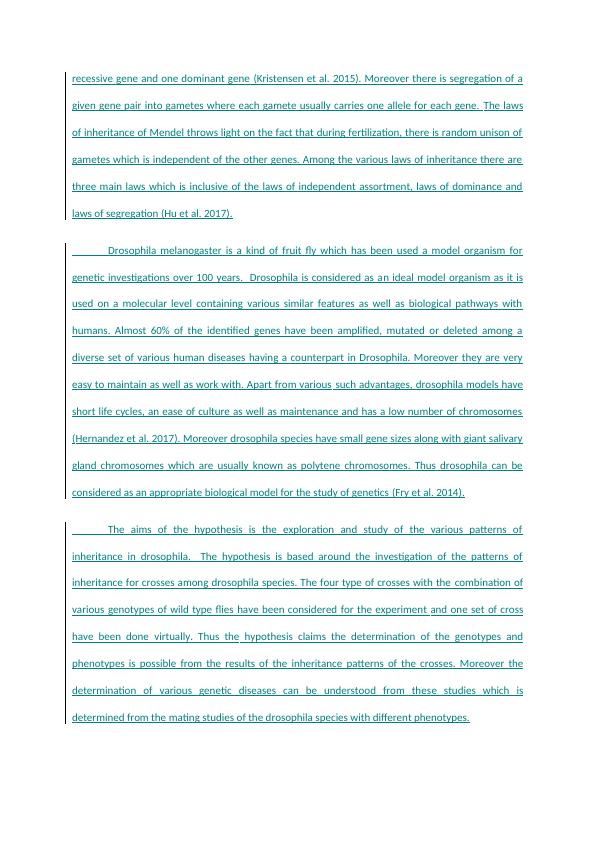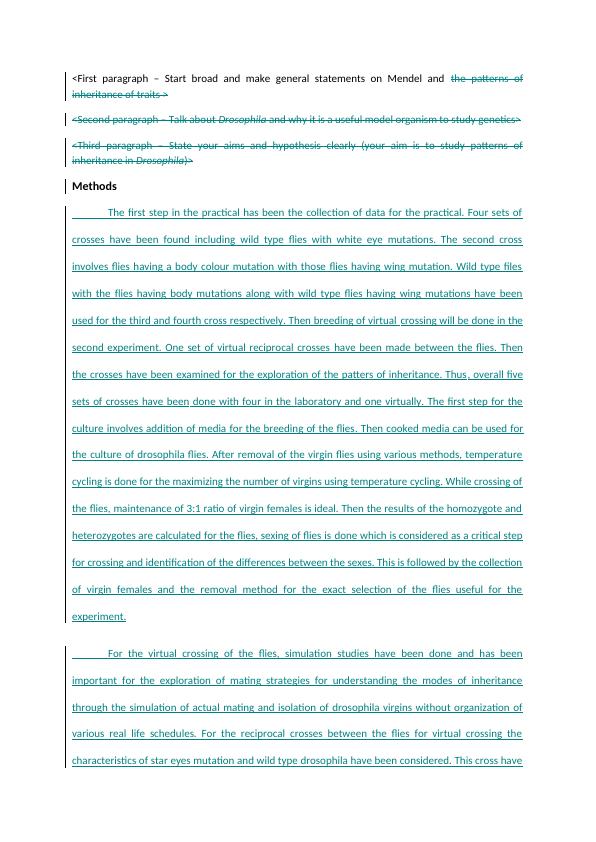Exploration of Inheritance Patterns in Drosophila Species
12 Pages3321 Words48 Views
Added on 2023-02-01
About This Document
This experiment explores the inheritance patterns of Drosophila species through breeding and crosses. It focuses on understanding the phenotypic and genotypic characteristics of different generations. The study is based on Gregor Mendel's laws of inheritance and the use of Drosophila as a model organism. The results of the crosses reveal the dominance and recessiveness of different traits.
Exploration of Inheritance Patterns in Drosophila Species
Added on 2023-02-01
ShareRelated Documents
Topic: BIOLOGY
Name of the Student:
Name of the University:
Author’s note:
Name of the Student:
Name of the University:
Author’s note:

<Practical report template>
Concepts in Biology 0483 – 2019 Semester 1.
<This template will help you write and structure your report. Fill in the blank and remove any text in
brackets, including this section.>
<Provide a descriptive title> Exploration of the inheritance patterns through
crosses between Drosophila species
Abstract
Over the years Gregor Johan Mendel has been considered as the father of genetics due to
his contribution in the field of genetics and formulation of the laws of inheritance. Drosophila
species are the most common models for studying the various inheritance patterns in genetics. In
this experiment, the main research thesis would revolve around the exploration of inheritance
patterns of Drosophila species through breeding and their crosses. The experiments with four sets of
characteristics have been done and the other set would be determined through a virtual cross. Thus
exploration of the various inheritance patterns through crosses would give an insight into the
phenotypic and genotypic characteristics of the various generations of Drosophila.
<Give a very short summary of your entire study. You need to include a sentence from your
introduction, methods, results and discussion.>
Introduction
Gregor Johann Mendel is known as the father of genetics who has been instrumental in the
formulation of fundamental principle regarding inheritance of traits. Mendel’s traits has been
considered as those traits controlled by single locus in inheritance patterns (Sujwoski et al. 2015).
Various diseases are caused by inheritance according to the laws of Mendel. Further in classical
genetics the hereditary determinants which are considered as finite factors are known as genes.
Moreover in biological cross of two lines one of the pair of genes has been considered as the
homozygous alleles and the other pair is known as the heterozygous alleles. The gene pair for the
homozygous allele is for the dominant trait while for the heterozygous progeny there will be one
Concepts in Biology 0483 – 2019 Semester 1.
<This template will help you write and structure your report. Fill in the blank and remove any text in
brackets, including this section.>
<Provide a descriptive title> Exploration of the inheritance patterns through
crosses between Drosophila species
Abstract
Over the years Gregor Johan Mendel has been considered as the father of genetics due to
his contribution in the field of genetics and formulation of the laws of inheritance. Drosophila
species are the most common models for studying the various inheritance patterns in genetics. In
this experiment, the main research thesis would revolve around the exploration of inheritance
patterns of Drosophila species through breeding and their crosses. The experiments with four sets of
characteristics have been done and the other set would be determined through a virtual cross. Thus
exploration of the various inheritance patterns through crosses would give an insight into the
phenotypic and genotypic characteristics of the various generations of Drosophila.
<Give a very short summary of your entire study. You need to include a sentence from your
introduction, methods, results and discussion.>
Introduction
Gregor Johann Mendel is known as the father of genetics who has been instrumental in the
formulation of fundamental principle regarding inheritance of traits. Mendel’s traits has been
considered as those traits controlled by single locus in inheritance patterns (Sujwoski et al. 2015).
Various diseases are caused by inheritance according to the laws of Mendel. Further in classical
genetics the hereditary determinants which are considered as finite factors are known as genes.
Moreover in biological cross of two lines one of the pair of genes has been considered as the
homozygous alleles and the other pair is known as the heterozygous alleles. The gene pair for the
homozygous allele is for the dominant trait while for the heterozygous progeny there will be one

recessive gene and one dominant gene (Kristensen et al. 2015). Moreover there is segregation of a
given gene pair into gametes where each gamete usually carries one allele for each gene. The laws
of inheritance of Mendel throws light on the fact that during fertilization, there is random unison of
gametes which is independent of the other genes. Among the various laws of inheritance there are
three main laws which is inclusive of the laws of independent assortment, laws of dominance and
laws of segregation (Hu et al. 2017).
Drosophila melanogaster is a kind of fruit fly which has been used a model organism for
genetic investigations over 100 years. Drosophila is considered as an ideal model organism as it is
used on a molecular level containing various similar features as well as biological pathways with
humans. Almost 60% of the identified genes have been amplified, mutated or deleted among a
diverse set of various human diseases having a counterpart in Drosophila. Moreover they are very
easy to maintain as well as work with. Apart from various such advantages, drosophila models have
short life cycles, an ease of culture as well as maintenance and has a low number of chromosomes
(Hernandez et al. 2017). Moreover drosophila species have small gene sizes along with giant salivary
gland chromosomes which are usually known as polytene chromosomes. Thus drosophila can be
considered as an appropriate biological model for the study of genetics (Fry et al. 2014).
The aims of the hypothesis is the exploration and study of the various patterns of
inheritance in drosophila. The hypothesis is based around the investigation of the patterns of
inheritance for crosses among drosophila species. The four type of crosses with the combination of
various genotypes of wild type flies have been considered for the experiment and one set of cross
have been done virtually. Thus the hypothesis claims the determination of the genotypes and
phenotypes is possible from the results of the inheritance patterns of the crosses. Moreover the
determination of various genetic diseases can be understood from these studies which is
determined from the mating studies of the drosophila species with different phenotypes.
given gene pair into gametes where each gamete usually carries one allele for each gene. The laws
of inheritance of Mendel throws light on the fact that during fertilization, there is random unison of
gametes which is independent of the other genes. Among the various laws of inheritance there are
three main laws which is inclusive of the laws of independent assortment, laws of dominance and
laws of segregation (Hu et al. 2017).
Drosophila melanogaster is a kind of fruit fly which has been used a model organism for
genetic investigations over 100 years. Drosophila is considered as an ideal model organism as it is
used on a molecular level containing various similar features as well as biological pathways with
humans. Almost 60% of the identified genes have been amplified, mutated or deleted among a
diverse set of various human diseases having a counterpart in Drosophila. Moreover they are very
easy to maintain as well as work with. Apart from various such advantages, drosophila models have
short life cycles, an ease of culture as well as maintenance and has a low number of chromosomes
(Hernandez et al. 2017). Moreover drosophila species have small gene sizes along with giant salivary
gland chromosomes which are usually known as polytene chromosomes. Thus drosophila can be
considered as an appropriate biological model for the study of genetics (Fry et al. 2014).
The aims of the hypothesis is the exploration and study of the various patterns of
inheritance in drosophila. The hypothesis is based around the investigation of the patterns of
inheritance for crosses among drosophila species. The four type of crosses with the combination of
various genotypes of wild type flies have been considered for the experiment and one set of cross
have been done virtually. Thus the hypothesis claims the determination of the genotypes and
phenotypes is possible from the results of the inheritance patterns of the crosses. Moreover the
determination of various genetic diseases can be understood from these studies which is
determined from the mating studies of the drosophila species with different phenotypes.

<First paragraph – Start broad and make general statements on Mendel and the patterns of
inheritance of traits >
<Second paragraph – Talk about Drosophila and why it is a useful model organism to study genetics>
<Third paragraph – State your aims and hypothesis clearly (your aim is to study patterns of
inheritance in Drosophila)>
Methods
The first step in the practical has been the collection of data for the practical. Four sets of
crosses have been found including wild type flies with white eye mutations. The second cross
involves flies having a body colour mutation with those flies having wing mutation. Wild type files
with the flies having body mutations along with wild type flies having wing mutations have been
used for the third and fourth cross respectively. Then breeding of virtual crossing will be done in the
second experiment. One set of virtual reciprocal crosses have been made between the flies. Then
the crosses have been examined for the exploration of the patters of inheritance. Thus, overall five
sets of crosses have been done with four in the laboratory and one virtually. The first step for the
culture involves addition of media for the breeding of the flies. Then cooked media can be used for
the culture of drosophila flies. After removal of the virgin flies using various methods, temperature
cycling is done for the maximizing the number of virgins using temperature cycling. While crossing of
the flies, maintenance of 3:1 ratio of virgin females is ideal. Then the results of the homozygote and
heterozygotes are calculated for the flies, sexing of flies is done which is considered as a critical step
for crossing and identification of the differences between the sexes. This is followed by the collection
of virgin females and the removal method for the exact selection of the flies useful for the
experiment.
For the virtual crossing of the flies, simulation studies have been done and has been
important for the exploration of mating strategies for understanding the modes of inheritance
through the simulation of actual mating and isolation of drosophila virgins without organization of
various real life schedules. For the reciprocal crosses between the flies for virtual crossing the
characteristics of star eyes mutation and wild type drosophila have been considered. This cross have
inheritance of traits >
<Second paragraph – Talk about Drosophila and why it is a useful model organism to study genetics>
<Third paragraph – State your aims and hypothesis clearly (your aim is to study patterns of
inheritance in Drosophila)>
Methods
The first step in the practical has been the collection of data for the practical. Four sets of
crosses have been found including wild type flies with white eye mutations. The second cross
involves flies having a body colour mutation with those flies having wing mutation. Wild type files
with the flies having body mutations along with wild type flies having wing mutations have been
used for the third and fourth cross respectively. Then breeding of virtual crossing will be done in the
second experiment. One set of virtual reciprocal crosses have been made between the flies. Then
the crosses have been examined for the exploration of the patters of inheritance. Thus, overall five
sets of crosses have been done with four in the laboratory and one virtually. The first step for the
culture involves addition of media for the breeding of the flies. Then cooked media can be used for
the culture of drosophila flies. After removal of the virgin flies using various methods, temperature
cycling is done for the maximizing the number of virgins using temperature cycling. While crossing of
the flies, maintenance of 3:1 ratio of virgin females is ideal. Then the results of the homozygote and
heterozygotes are calculated for the flies, sexing of flies is done which is considered as a critical step
for crossing and identification of the differences between the sexes. This is followed by the collection
of virgin females and the removal method for the exact selection of the flies useful for the
experiment.
For the virtual crossing of the flies, simulation studies have been done and has been
important for the exploration of mating strategies for understanding the modes of inheritance
through the simulation of actual mating and isolation of drosophila virgins without organization of
various real life schedules. For the reciprocal crosses between the flies for virtual crossing the
characteristics of star eyes mutation and wild type drosophila have been considered. This cross have

End of preview
Want to access all the pages? Upload your documents or become a member.
Related Documents
Lab report: Drosophila melanogaster eye colorlg...
|8
|1764
|113
Drosophila melanogaster eye color PDFlg...
|8
|1715
|194
Genetics HBSS Research Paper 2022lg...
|5
|981
|19
BIOL2006 - Gene Mapping Assignmentlg...
|13
|2597
|65
Principles of Inheritance and Genetic Traitslg...
|5
|817
|362
Biological Significance of Meiosis and Inheritance Patternslg...
|11
|1444
|350
